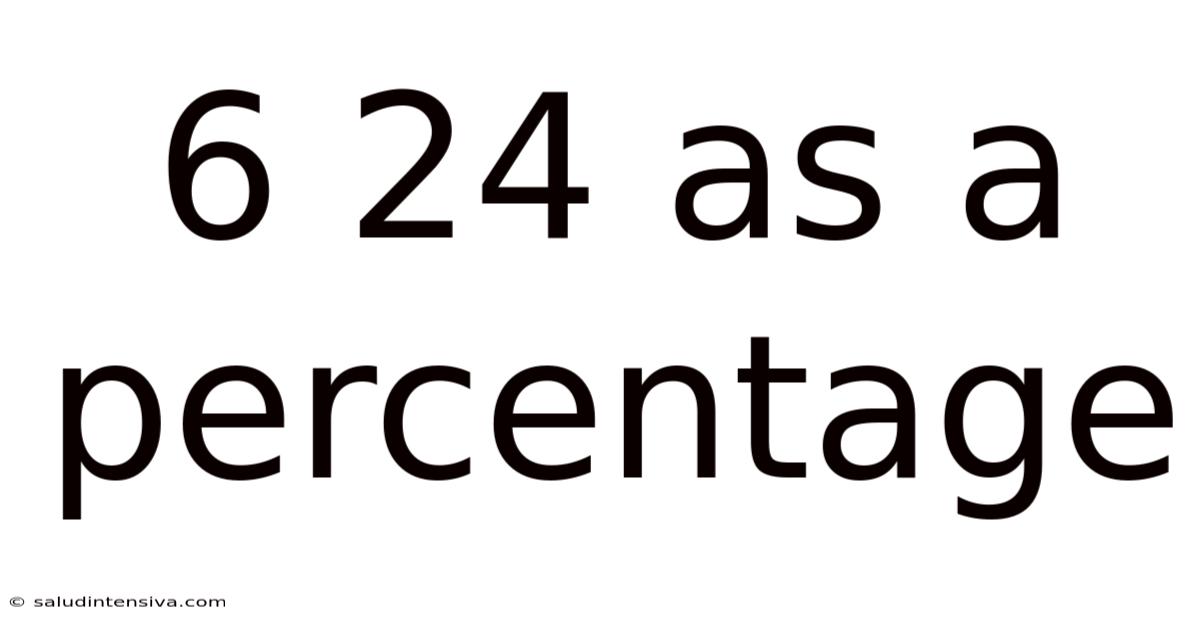6 24 As A Percentage
saludintensiva
Sep 12, 2025 · 5 min read

Table of Contents
Understanding 6/24 as a Percentage: A Comprehensive Guide
Many everyday situations require converting fractions into percentages. Understanding this process is crucial for various applications, from calculating discounts and interest rates to analyzing data and understanding statistical probabilities. This article will delve deep into how to convert the fraction 6/24 into a percentage, exploring the underlying mathematical principles and providing practical examples. We'll also explore related concepts to broaden your understanding of percentages and fractions.
Introduction: The Basics of Percentages and Fractions
Before we tackle 6/24, let's refresh our understanding of percentages and fractions. A fraction represents a part of a whole. It's expressed as a ratio of two numbers, the numerator (top number) and the denominator (bottom number). For instance, in the fraction 6/24, 6 is the numerator and 24 is the denominator. This means 6 out of 24 parts of a whole.
A percentage is a way of expressing a fraction as a proportion of 100. The symbol "%" represents "per cent" or "out of 100". Therefore, 50% means 50 out of 100, or 50/100. Converting fractions to percentages involves finding the equivalent fraction with a denominator of 100, or using a more efficient method, which we'll discuss shortly.
Step-by-Step Conversion of 6/24 to a Percentage
There are several ways to convert 6/24 into a percentage. Let's explore two common methods:
Method 1: Simplifying the Fraction First
This method involves simplifying the fraction to its lowest terms before converting to a percentage. This simplifies the calculation and makes it easier to understand.
-
Simplify the fraction: The fraction 6/24 can be simplified by dividing both the numerator and the denominator by their greatest common divisor (GCD), which is 6.
6 ÷ 6 = 1 24 ÷ 6 = 4
This simplifies 6/24 to 1/4.
-
Convert the simplified fraction to a decimal: To convert 1/4 to a decimal, divide the numerator (1) by the denominator (4):
1 ÷ 4 = 0.25
-
Convert the decimal to a percentage: Multiply the decimal by 100 and add the percentage sign (%):
0.25 × 100 = 25%
Therefore, 6/24 is equal to 25%.
Method 2: Direct Conversion from Fraction to Percentage
This method involves directly converting the fraction to a percentage without simplifying first.
-
Convert the fraction to a decimal: Divide the numerator (6) by the denominator (24):
6 ÷ 24 = 0.25
-
Convert the decimal to a percentage: Multiply the decimal by 100 and add the percentage sign (%):
0.25 × 100 = 25%
This method yields the same result: 6/24 is equal to 25%. While this method might seem quicker, simplifying the fraction first can often make the calculation easier, especially with more complex fractions.
Further Exploration: Understanding the Concept of 25%
Now that we've established that 6/24 equals 25%, let's explore what this percentage represents. 25% signifies one quarter (1/4) of a whole. Imagine a pizza cut into four equal slices. 25% represents one of those slices. This understanding is applicable in various real-world scenarios.
For example, if a store offers a 25% discount on an item, it means you'll pay only 75% (100% - 25%) of the original price. Similarly, if you correctly answered 25% of the questions on a test with 40 questions, you answered 10 questions correctly (25% of 40 = 10).
Real-World Applications of Percentage Calculations
The ability to convert fractions to percentages is essential in many real-world situations, including:
- Finance: Calculating interest rates, discounts, taxes, and profit margins.
- Retail: Determining sale prices, markups, and discounts.
- Statistics: Representing data as proportions and probabilities.
- Science: Expressing experimental results and data analysis.
- Everyday Life: Calculating tips, splitting bills, and understanding proportions in recipes.
Frequently Asked Questions (FAQ)
-
Q: Why is it important to simplify fractions before converting to percentages?
A: Simplifying fractions makes the subsequent calculations easier and less prone to errors. It also helps in visualizing the proportion more clearly.
-
Q: Can I convert any fraction to a percentage?
A: Yes, any fraction can be converted to a percentage by dividing the numerator by the denominator and multiplying the result by 100.
-
Q: What if the resulting decimal has many digits after the decimal point?
A: You can round the decimal to a certain number of decimal places depending on the required level of accuracy. For example, you might round 0.33333... to 0.33 or 0.333.
-
Q: Are there any online tools to convert fractions to percentages?
A: Yes, many online calculators and converters are available that can perform this conversion quickly and accurately.
Conclusion: Mastering Percentage Conversions
Converting fractions to percentages is a fundamental mathematical skill with widespread applications. Understanding the process, as demonstrated with the conversion of 6/24 to 25%, empowers you to solve various problems in different contexts. By mastering this skill, you'll gain a deeper understanding of proportions and ratios, which are essential concepts in numerous fields. Remember to always simplify fractions whenever possible to make the conversion process smoother and less error-prone. The more you practice, the more confident and proficient you'll become in tackling percentage calculations. This understanding extends beyond simple conversions and allows for a more thorough understanding of numerical data representation and analysis in various real-world scenarios. It’s a crucial skill for both academic and professional success.
Latest Posts
Latest Posts
-
1 1 4 In Inches
Sep 12, 2025
-
1 1 8 X 3
Sep 12, 2025
-
Gcf Of 60 And 60
Sep 12, 2025
-
13 16 As A Decimal
Sep 12, 2025
-
14 Acres To Sq Ft
Sep 12, 2025
Related Post
Thank you for visiting our website which covers about 6 24 As A Percentage . We hope the information provided has been useful to you. Feel free to contact us if you have any questions or need further assistance. See you next time and don't miss to bookmark.